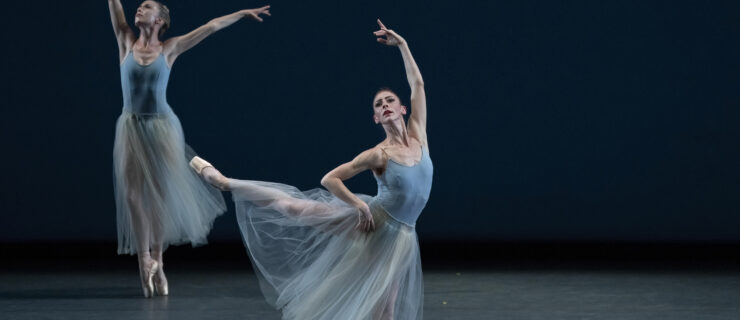The Early-Career-Dancer’s Guide to Company Contracts
Landing your first-ever ballet company contract is cause for celebration.
But a contract is more than just a ticket to living out your dreams as a professional ballet dancer. It’s a legal document laying out the terms of your employment—from how much you get paid to when exactly you’ll be expected to work to what benefits you’ll be offered—and understanding it is vitally important.
“I know the mindset that dancers have when they get a contract—Oh, my gosh, I got a contract, dream company, I don’t care, I’m just excited,” says Semperoper Dresden dancer Rebecca Haw, founder of CODA, an agency for ballet dancers. “I’ve been there—we all have.”
Even if you don’t yet have much negotiating power as an early-career dancer, knowing what your contract says and what it means for both your day-to-day life and your long-term future can empower you to have ownership over your own career, and to be prepared and informed should any issues arise.
“Dancers need to realize that, just like port de bras, this is part of what they do,” says Maria Konrad, director of Nashville Ballet 2. “We’re constantly reaching, stretching, and growing in our dancing. And it’s okay to reach, stretch, and grow on the business side, too.”
What Is a Contract?
When a company wants to hire you, you’ll typically be presented with a multipage contract that serves as an agreement between you, as an individual, and the organization that’s employing you, says Tracy Jones, senior negotiator at the American Guild of Musical Artists (AGMA, the union that represents many ballet companies in the U.S.) and a former professional ballet dancer. That agreement will include information specific to your employment, like your contract dates, salary, and rank.
The rest of the information about what’ll be expected of you, and what you should expect from your company in return, will be located in a larger governing document that applies to the company more generally. In a union company, that will be a collective-bargaining agreement (CBA), which is negotiated every few years and overseen by the union. At a nonunion company, it may be a more informal document, like a company handbook.
What to Do With Your Contract
Contracts can be intimidating, especially when they’re long and full of confusing legalese. Still, it’s essential to read them—both your individual contract and the larger CBA or company guidelines—before you sign anything.
If you don’t understand something, do your research, and don’t be afraid to ask questions. Konrad encourages dancers to run their contracts by trusted friends or family members, and to take the time you need to understand what you’re signing. (If you’re feeling rushed by the company, that could be a red flag, she says.) She also cautions against signing a contract if you haven’t visited a company in person to make sure it’s a good fit.

In AGMA companies, the negotiator and business representative assigned to work with your company can be an invaluable resource for questions and concerns, as can the dancer delegates (company members who serve as intermediaries between the union and the company). Nonunion companies may have similar dancer representatives who can answer your questions once you’ve joined the ranks.
Union vs. Nonunion Contracts
Most larger ballet companies in the U.S. are unionized as part of AGMA. Jones says this means that, for union members who dance with AGMA companies, they pay a flat annual fee in addition to dues taken out of their paychecks (as a small percentage of their salary) and enjoy the protections and resources that come with being a union member.

For instance: New dancers at AGMA companies participate in an orientation, where AGMA staff explain details of the contract and CBA and answer questions. Should you ever find that your company is in violation of your CBA, the union is there to ensure that the problem is resolved.
At a nonunion company, protections like mandatory breaks should be listed in your company handbook, and hopefully adhered to. But Jones says enforcing what’s been agreed to without a union could be challenging. It’s also typically up to the dancers themselves to approach management about violations or issues, which can be intimidating and deter them from speaking up.
At union companies, CBAs are renegotiated every few years, with professional AGMA negotiators working to support company members. They can help dancers advocate for and win CBA improvements like higher entry-level pay for all ranks, or parental leave.
There may be less-formalized opportunities to negotiate for better benefits, working conditions, and protections at nonunion companies, but, in general, it will be up to dancers to advocate for themselves. Jones says that, typically, nonunion contracts are less balanced—meaning they favor management—than union contracts that have been negotiated and agreed upon by both sides.
Is Your Contract Negotiable?
While pay rates outlined in an AGMA CBA are just a minimum, it’s not common for early-career dancers to negotiate their salaries, says Jones. What’s more common, she says, is for artists coming from another company to negotiate to have some automatic seniority in their new contract, or to match their previous salary. It doesn’t hurt to (respectfully) ask, and Haw says she’s seen dancers have success in negotiating other parts of their contract, such as skipping over a probationary period.
One negotiating tip for AGMA members: You can access other AGMA companies’ CBAs in your online portal, says Pacific Northwest Ballet principal and AGMA delegate Sarah-Gabrielle Ryan, to see how your baseline compensation compares. She encourages non-AGMA members to have frank conversations about salaries with dancers inside and outside their company. “Having as much discussion as possible helps you have a better understanding of the ballet world as a whole.”
What to Look For
Pay. Your individual contract should state your rank, salary, and pay schedule, as well as policies around overtime, risk pay, and bonuses. An AGMA CBA should also have information about salary minimums for all ranks and seniority levels of the company.
Length of contract and termination details. In addition to stating how long the contract is, you’ll want to see details about how much notice you’ll receive should the company not renew your contract (and, similarly, how much notice you’ll be expected to give should you want to leave). Ideally, says Ryan, you’ll get a few months of notice so that you’ll have time to audition for a new position. But some nonunion contracts are at-will, meaning you can be let go at any time, which Jones says is a red flag.
Layoff weeks. Your contract should also outline how many weeks per year you’ll be on layoff. It should clarify details and protocols around how you’re paid or not during layoff periods, and whether you’re allowed to work other jobs or collect unemployment.
Paid and unpaid leave. You may need to take time off for illnesses, injuries, family emergencies, parental leave, and other life events. Your contract should outline procedures for taking leave, and information about whether this time off will be paid. Pay special attention to policies around injuries, says Haw. If you’re in a position to do so, think twice about signing if you will not be compensated via workers compensation while injured.
Daily schedule and breaks. You should hopefully receive guidelines about what your daily schedule will look like, such as how early or late you’ll be expected to be at the studios or theater, how many hours you can work in a day and week, how often you’ll be given breaks, and whether company class is mandatory or optional.
Shoe allotment. Most ballet company contracts include a shoe allotment. Pointe shoes are expensive, so if your company doesn’t provide them, take a close look at your salary and deduct what you think you’ll be spending on shoes.
Travel. If you’ll be touring frequently, your CBA or company handbook should explain how travel arrangements are handled (for instance, how you’re compensated for travel time), as well as information about per diem and meals. If they don’t, be sure to ask.
Health benefits. Your contract should stipulate how your health insurance will work: Will it be year-round or just during periods where you’re working? Do you have to pay for it all yourself or will the company subsidize it? Are dental and vision included? It should also include any health resources available to you, such as physical therapy, massages, or mental health counseling.
Retirement benefits. Ideally, your company has a retirement plan laid out in your contract. Some companies may even contribute to your retirement.
Communications. Some contracts may include guidelines for communications between dancers and management. For instance PNB’s CBA stipulates that all dancer evaluations be recorded, and at Milwaukee Ballet, dancers must receive seven days of notice prior to any meetings related to health, weight, or physical appearance, and those meetings must be recorded and supervised by a health-care professional.
Media rights. With the rise of streamed performances, Jones says it’s becoming more common to see contract language around dancers receiving fees when their performances or likeness are used. Contracts may also include information about how and when filming and photography may happen, and whether dancers can approve images and videos of themselves, as well as language about what dancers can post on their personal social media pages, including possible limitations on paid partnerships and influencer marketing, and/or limitations to usage of media containing repertoire.
Other possible benefits. CBAs can include a range of other benefits and stipulations, on topics like free parking for dancers, costumes and wigs that match dancers’ skin tones and hair textures, health and safety protections (such as safe flooring and regulating room temperature), the role of dancer representatives in executive hiring, and how dancers are billed and credited.






